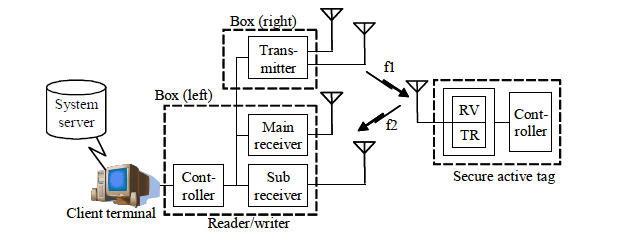The active RFID tags have their own source of power. They can transmit stronger signals over long distances and can operate in rugged environment for many years. Because of the on-board source of power they are larger in size and expensive. Then too Active RFID and Real-Time Location solutions (RTLS) are saving millions of dollars for enterprises around the world. The low power active tags usually look like a deck of playing cards.

Fig. 1: A Figure Representing Architecture of an Active RFID Tag
Active RFID tags are basically miniature radio flares and contain both a radio transmitter and a radio receiver circuit. An Active RFID tag consists of three main parts: tags, readers and servers.
The tags consist of an antenna and IC’s. The reader in their range communicates with the tags in accordance with the protocol (standard/ proprietary) that they follow. The readers can collect information from multiple tags at the same time. The readers then pass this information on to the servers through Serial ports (e.g. RS-232), USB, Ethernet or wireless means. The servers have software running on them which uses the information sent by the readers to carry out tasks such as locating the tag.
The recent Active RFID tags use 2.4 GHz as their operating frequency because this frequency range is available worldwide. Although these tags require transmitting power, the time duration of transmitting radio signal is very short. So most of the time, they remain quiescent. Because of this steady state mode, they control the battery life of the tag. The normal lifespan of the battery is approximately one year.
There is no need for the RFID reader to transmit a large amount of power as the active RFID tag has an onboard powers source. The advanced Active tags can also form ad hoc peer networks with each other.
FEATURES:
· Some tags have their own specialized reader specially for the asset tracking system, while others are compatible with existing standards based on Wi-Fi (802.11) networks.
· Some tags only offer basic long range presence detection, while others use some algorithm such as RSSI or TDOA to determine location in real time.
· Tags with small batteries have low power consumption and can give a compact and long life span.
· Battery life gets conserved by using motion sensors as they enable separate transmission intervals for tags, which are in motion or stationary.
· Some tags automatically modify their behavior as they pass through specific point which can be used to switch off the tag when leaving the premises to save battery.
· The tags carry minimal valuable data or have trusted security mechanism for data protection.
APPLICATIONS:
· General motors’ presently uses RFID tags to track the movement of auto chassis at various levels in the assembly plants.
· Medical equipments and sponges are tagged to prevent them from being left behind during a surgical procedure causing injury or death.
· Currently used by early adopters. Usage scenarios include RFIO enabled identification badges used in companies, toll checkpoints, supply chain management of high value items and drug tracking.
· A more well-known application of RFID has been in the cattle industry for domestic animals tagging.
· Also currently in use to design a railway vehicle detection system which are used to recognize traffic and passenger information, safeguarding system, vehicle positioning system.
Filed Under: Articles


Questions related to this article?
👉Ask and discuss on EDAboard.com and Electro-Tech-Online.com forums.
Tell Us What You Think!!
You must be logged in to post a comment.